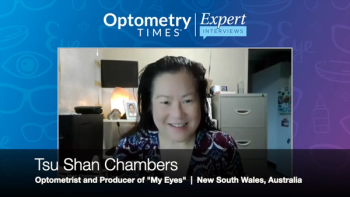
- February digital edition 2021
- Volume 13
- Issue 2
Patient experiences sudden decrease in vision
Imaging shows optic disc swelling and retinal nerve fiber layer thickening
An 81-year-old female presented with a chief complaint of a painless reduction in vision for the last 5 days. The patient was unsure of which eye the vision was reduced in but reported a constant reduction in visual acuity with no improvement. The patient denied any changes to medical history, recent ocular trauma, flashes of light, or associated symptoms. She reported her vision did not improve with her glasses. The patient lives alone but was accompanied to the visit by her son.
Examination and testing
The patient has a medical history of smoking, hyperlipidemia, hypertension, sleep apnea, arthritis, anxiety, and depression— which the patient is being treated for and reports good compliance with medication. Her medications include diazepam 5 mg, hydrochlorothiazide 12.5 mg, escitalopram 10 mg, simvastatin 20 mg, and trazodone 100 mg. The patient does not take hypertensive medication in the evening.
External examination revealed best corrected visual acuities (BCVA) of 20/30 OD and 20/60 OS. Pupils were 2 mm in bright light and 3 mm in dim light. They were brisk and reactive to light, and a Grade 3 left relative afferent pupillary defect was present. No pain or double vision was noted on extraocular movements but restriction was noted on confrontation visual field OS greater than OD.
Slit-lamp exam revealed age-related cataracts (2+ nuclear sclerosis, trace posterior subcapsular) and cortical spoking OU. The patient had intraocular pressures (IOP) of 15 mm Hg OD and 12 mm Hg OS. The remaining anterior segment exam was unremarkable.
Dilated fundus exam revealed optic nerve pallor OD and circumferential pallid optic nerve swelling OS. (+) Arteriole attenuation OU. (-) Disc hemorrhages OS. There were no hemorrhages, exudates, or edema in the macula OU. This can be seen in Figure 1 and Figure 2. The patient’s previously recorded cup-to-disc ratio was 0.3 OU.
Optic nerve optical coherence tomography (OCT) showed signal strengths of 7/10 OD and 5/10 OS. Poor signal strength and high segmentation errors OS skew results compared to the normative database. The right eye showed an average retinal nerve fiber layer (RNFL) thickness of 49 μm. On the RNFL thickness plot, the right eye shows generalized thinning in the superior, inferior, and temporal quadrants. The optic nerve OCT of the left eye confirms the appearance of swelling of the left optic disc. The RNFL thickness plot of the left eye shows pathological thickening. The optic nerve OCT results can be seen on Figure 3. A ganglion cell analysis may provide more conclusive information in this case.
She was sent for immediate blood work, including C-reactive protein (CRP), erythrocyte sedimentation rate (ESR), platelet count, and complete blood count with differential. She was referred for a next-day neuro-ophthalmology workup.
Follow-up
The patient returned the next morning for her neuro-ophthalmology appointment and was now accompanied by her daughter. BCVA was 20/30 OD and a slow 20/50 OS.
Her blood work results showed a normal platelet count and ESR. However, her CRP level was elevated, measuring 16mg/L.
A 24-2 Swedish Interactive Testing Algorithm (SITA) Fast visual field was performed at this visit. The right eye showed good reliability with few fixation errors, low false positives and negatives. The test revealed a macula-sparing superior altitudinal defect with an inferior arcuate defect in the patient’s right eye. The left eye showed good reliability with few fixation errors, low false positives and negatives.
This patient has a severely depressed visual field OS. She was not able to perceive the light throughout the majority of the field tested, even when shown on the brightest setting. However, within the central 8° of fixation, one point still shows some sensitivity to light. This most likely accounts for the patient’s BCVA of 20/50 OS. The 24-2 SITA Fast visual field results for the right and left eye can be seen in Figure 4 and Figure 5, respectively.
Diagnosis and treatment
At this time the differential diagnosis includes: non-arteritic anterior ischemic optic neuropathy (NAAION), temporal arteritis, Foster-Kennedy syndrome and pseudo–Foster-Kennedy syndrome (PFKS).
NAAION was at the top of the diagnosis list due to the patient’s medical history and previous optic nerve head appearance. Being an overweight, 81-year-old female with a history of hypertension and hyperlipidemia, with a classic “disc at risk”optic nerve head, the patient is at a high risk of NAAION.
Although this patient fits the normal age group for giant cell arteritis (GCA), she denied jaw claudication, scalp tenderness, or temporal headaches. Furthermore, her bloodwork revealed an elevated CRP and a normal ESR. One would usually expect both elevated in GCA with or without thrombocytopenia.
The lack of constitutional symptoms of GCA suggested PFKS. Foster-Kennedy syndrome and PFKS are further supported as differentials due to the appearance of the optic nerve heads on funduscopy.
The patient was referred for a brain and orbital MRI to rule out a compressive etiology, which would be indicative of Foster-Kennedy syndrome.
PFKS presents similarly with a unilateral optic atrophy and contralateral disc edema. It is caused by ischemic, infectious, and infiltrative events rather than compressive. Risk factors include hypertension, diabetes, hyperlipidemia, smoking, nocturnal hypotension, and sleep apnea.
Having the majority of these risk factors, the patient was most likely undergoing PFKS secondary to NAAION.
The patient was educated that she most likely experienced vision loss OD due to vasculopathic events to her optic nerve. She was further informed that the same vasculopathic process is now occurring OS, which she is currently symptomatic.
The patient’s driving privileges have been suspended due to her severe visual field constriction.
She was referred to her primary-care physician (PCP) for an assessment of stroke and heart attack risk. The PCP added clopidogrel to the patient’s medications in order to reduce subsequent cerebrovascular and cardiovascular events.
The patient reported via follow-up phone call that her brain and orbit MRI were negative.
This patient may benefit from working with a low-vision specialist and support group for her recent diagnosis.
Articles in this issue
almost 5 years ago
Quiz: Patient experiences sudden decrease in visionalmost 5 years ago
Soft toric lens fitting practices not meeting patient needsalmost 5 years ago
Review Duane’s retraction syndrome diagnosis and treatmentalmost 5 years ago
Point-of-care testing helps dry eye diagnosisalmost 5 years ago
How to improve telehealthalmost 5 years ago
High IOP, uveitis lead to Posner-Schlossman diagnosisalmost 5 years ago
Differential key to diagnosing idiopathic orbital inflammationalmost 5 years ago
How to avoid patient nonadherenceNewsletter
Want more insights like this? Subscribe to Optometry Times and get clinical pearls and practice tips delivered straight to your inbox.













































.png)


